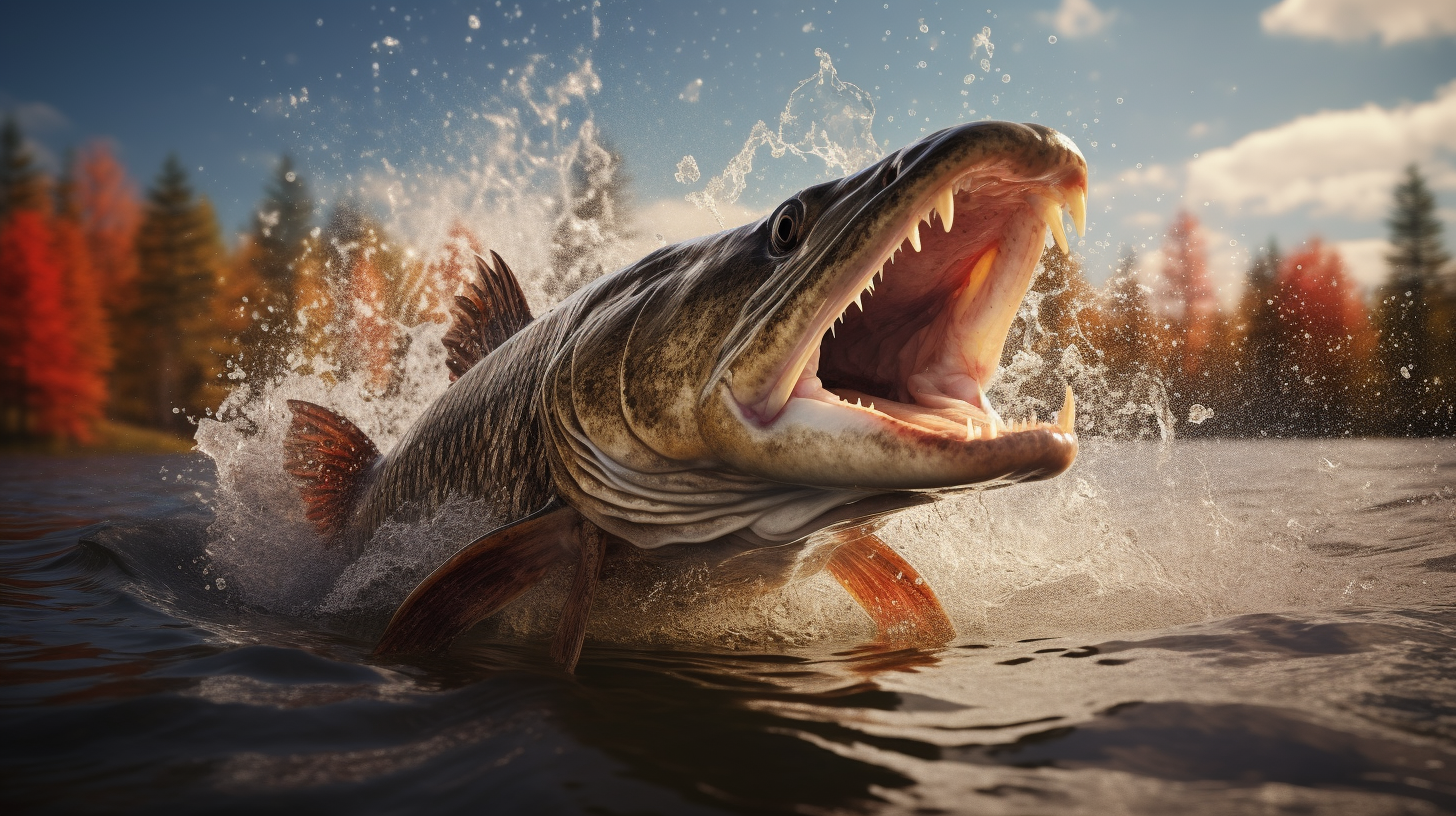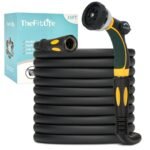Muskellunge, or muskie for short, is a freshwater fish species that is highly prized by anglers for its size and fighting ability. This fish is native to North America and is found in a variety of habitats, including lakes, rivers, and streams.
With its sharp teeth and aggressive nature, muskie is often referred to as the “water wolf” and is considered one of the most challenging fish to catch.
To catch muskie, it’s important to understand its habitat and diet. Muskie prefers to live in clear, weedy lakes and rivers with deep and shallow basins. It feeds on a variety of prey, including fish, frogs, and small mammals, and is known for its ability to swallow prey whole.
Anglers who want to catch muskie need to use specialized fishing techniques and tackle, as well as be aware of local regulations and conservation efforts to protect this species.
Key Takeaways
- Muskellunge is a highly prized freshwater fish species known for its size and fighting ability.
- To catch muskie, anglers need to understand its habitat and diet and use specialized fishing techniques and tackle.
- It’s important to be aware of local regulations and conservation efforts to protect this species while fishing.
Habitat: Where to Find This Type of Fish
Muskellunge are found in a variety of freshwater habitats in North America, including rivers, lakes, and reservoirs. They prefer cool, clear water with abundant vegetation, rocky structure, and woody debris. Muskellunge are also known to inhabit brackish waters in coastal areas.
Muskellunge can be found in a range of water depths, from shallow weedy areas to deeper open water. They are often found near drop-offs, points, and other underwater structures where they can ambush prey.
Read More OutdoorGoodness Articles
Muskellunge are native to the Great Lakes region of North America, and can be found in lakes and rivers throughout the region, as well as in many other parts of the continent. They are most commonly found in the northern United States and Canada, but can be found as far south as Tennessee and North Carolina.
Muskellunge are often associated with other coolwater species such as northern pike, walleye, and smallmouth bass. They are top predators in their habitat, feeding on a variety of prey including fish, crayfish, frogs, and small mammals.
Overall, muskellunge are a versatile species that can adapt to a range of freshwater habitats. Whether you are fishing in a river or a lake, if you are looking for muskellunge, look for areas with structure, vegetation, and clear water.
Diet: The Secret to Catching This Fish Type
If you want to catch a Muskellunge, it is important to understand its diet. Muskellunge are ambush predators that rely on their keen vision and short-bursts of speed to capture prey. They are more adept to short burst style habits opposed to long slow cruising that is exhibited by some other fish species.
Muskellunge typically feed on a wide variety of prey, including fish, frogs, crayfish, and other aquatic animals. They are known to feed on anything that moves and fits in their mouth. The choice of prey is often dictated by the availability of food in their habitat.
When targeting Muskellunge, it is important to use lures and baits that mimic their natural prey. Large artificial lures that are typically five to 10 inches long, or longer, are often used to attract Muskellunge. These lures should be retrieved in a way that mimics the natural movement of the prey.
Live bait, such as large minnows or suckers, can also be effective in catching Muskellunge. When using live bait, it is important to use a large hook and a strong leader to prevent the fish from breaking the line.
In conclusion, understanding the Muskellunge’s diet is key to catching this elusive fish. By using lures and baits that mimic their natural prey, and by understanding their feeding habits, anglers can increase their chances of catching a Muskellunge.
Fishing Techniques: Mastering the Art of Catching This Fish Type
Muskellunge, also known as musky, is a challenging fish to catch. They are elusive and require patience, skill, and the right fishing equipment. Here are some techniques you can use to increase your chances of catching this fish type.
Use Large Artificial Lures
Muskellunge are known to go after large prey, so it’s best to use large artificial lures that are at least five to ten inches long. The longer the lure, the better your chances of attracting a musky. When choosing a lure, look for those that mimic the movements of live baitfish. Some popular lures for musky fishing include the Suick Thriller, the Buchertail, and the Cowgirl.
Fish in the Right Spots
Muskellunge prefer to stay in deeper waters, especially during warmer weather. Look for areas with a lot of underwater structure, such as weed beds, sunken objects, and drop-offs. These areas provide cover for musky and make it easier for them to ambush their prey. Musky are also known to follow baitfish, so look for areas where baitfish are abundant.
Use the Right Fishing Equipment
To catch musky, you need the right fishing equipment. Use a heavy-duty rod with a fast action and a strong reel with a high line capacity. You will also need a strong fishing line, preferably a braided line, with a test weight of at least 50 pounds. When fishing for musky, it’s important to use a leader to prevent the fish from biting through the line. A fluorocarbon leader with a test weight of at least 80 pounds is recommended.
Be Patient
Muskellunge are known as the “fish of 10,000 casts” for a reason. They are elusive and require a lot of patience to catch. Don’t give up if you don’t catch a musky right away. Keep casting and changing your lures until you find the right one. Remember, catching a musky is a challenge, but it’s also a rewarding experience.
By using these techniques, you can increase your chances of catching a muskellunge. Remember to be patient, use the right fishing equipment, and fish in the right spots. With a little practice and perseverance, you can master the art of catching this challenging fish type.
Tackle and Gear: Essential Equipment for This Fish Type
Muskellunge, also known as musky, are large and powerful fish that require specialized tackle and gear for successful fishing. Here are some essential equipment that you should consider when targeting musky:
- Rod and Reel: A heavy-duty rod and reel combo is recommended for musky fishing. Look for a rod that is at least 7 feet long and has a fast action with a heavy power rating. A reel with a high gear ratio and a strong drag system is also important.
- Line: Musky are known for their sharp teeth and powerful runs, so you need a strong and abrasion-resistant line. Braided line is a popular choice among musky anglers because it is strong, sensitive, and has low stretch. A line with a test strength of at least 50 pounds is recommended.
- Leaders: A leader is a short section of heavy monofilament or fluorocarbon line that is attached to the end of your main line. It serves as a shock absorber and protects your line from the musky’s teeth. Leaders should be at least 12 inches long and have a test strength of at least 80 pounds.
- Lures: Musky are aggressive predators that will strike at a variety of lures. Some popular musky lures include bucktails, jerkbaits, crankbaits, and topwater lures. Make sure to have a variety of colors, sizes, and styles in your tackle box.
- Net: Landing a musky can be a challenge, so having a large and sturdy landing net is important. Look for a net with a handle that is at least 6 feet long and a hoop that is at least 30 inches wide.
- Release Tools: Musky are a prized catch and should be handled with care to ensure their survival after release. Have a pair of long-nose pliers, hook cutters, and a jaw spreader in your tackle box to help safely remove hooks and revive the fish before releasing it.
By having the right tackle and gear, you can increase your chances of landing a musky and have a safe and enjoyable fishing experience.
Regulations: Stay Legal and Fish Responsibly
Muskellunge are managed as a trophy fish in New York, and minimum size regulations of 40 inches for inland waters and 54 inches for Great Lakes waters reflect that status. It is important to note that these regulations are subject to change, so be sure to check the most up-to-date regulations before heading out on the water.
To improve public safety and encourage visitors to State-owned and managed lands to practice responsible recreation, the New York State Department of Environmental Conservation (DEC) recently launched the “Love Our New York Lands and Waters” campaign. This campaign encourages visitors to follow the Leave No Trace principles and to properly dispose of all trash and litter.
In addition to size regulations, there are also bag limits in place for muskellunge. In New York, the daily bag limit is one fish per angler, and possession limit is two fish per angler. It is important to follow these regulations to ensure that the muskellunge population remains healthy and sustainable.
When fishing for muskellunge, it is also important to use proper gear and techniques to ensure a safe and successful catch-and-release. This includes using a strong and properly sized landing net, using barbless hooks to minimize harm to the fish, and handling the fish with wet hands or gloves to avoid damaging the protective slime layer on the fish’s skin.
By following these regulations and practicing responsible fishing techniques, anglers can help ensure that muskellunge populations remain healthy and sustainable for future generations to enjoy.
Tips and Tricks: Expert Tips for Catching More of This Fish Type
Muskellunge, also known as musky, is a prized fish among anglers due to its size and fighting spirit. Here are some expert tips to help you catch more muskies:
- Choose the right equipment: Use a heavy-duty rod and reel with a strong line as muskies are known to put up a fight. A wire leader is also recommended as muskies have sharp teeth that can cut through regular fishing lines.
- Find the right spot: Muskies are ambush predators that like to hide in weed beds, rocks, and other structures in the water. Look for areas with drop-offs or changes in depth, which can attract muskies.
- Use the right bait: Muskies are known to be picky eaters, so it’s important to use the right bait. Large lures, such as bucktails, jerkbaits, and topwater baits, are popular choices. Live bait, such as suckers or large minnows, can also be effective.
- Fish during the right time: Muskies are most active during low-light conditions, such as early morning and late evening. Fishing during these times can increase your chances of catching a musky.
- Be patient: Muskies can be elusive and difficult to catch, so it’s important to be patient. Don’t give up if you don’t catch one right away. Keep trying different spots, baits, and techniques until you find what works.
By following these tips and tricks, you can increase your chances of catching a musky and have a successful day on the water.
Conservation: Protecting This Fish Type
Muskellunge are a popular sport fish, but their populations have been threatened by habitat destruction, overfishing, and pollution. To ensure the long-term survival of this species, conservation efforts are necessary.
Habitat Protection and Enhancement
Maintaining and enhancing water quality and habitat are critical to the maintenance of healthy muskie populations. Shoreline development and erosion, unnatural water level fluctuations, invasive species, and wetland encroachment all threaten the stability of muskellunge populations. To protect their habitat, it is important to:
- Preserve and restore wetlands and riparian areas.
- Reduce sediment and nutrient runoff from agriculture and urban areas.
- Minimize shoreline development and erosion.
- Control invasive species.
Fishing Regulations
Muskellunge are a popular sport fish, but overfishing can threaten their populations. To ensure sustainable fishing, it is important to:
- Follow fishing regulations, such as size and bag limits.
- Practice catch-and-release fishing.
- Use appropriate gear and techniques to reduce injury to the fish.
Stocking Programs
Some states have implemented stocking programs to enhance muskie populations. These programs involve releasing muskellunge into lakes and rivers where they are not native. While stocking can be a useful tool for increasing muskie populations, it is important to:
- Use genetically diverse stock to maintain genetic health.
- Monitor the success of stocking programs to ensure they are effective.
- Avoid stocking in areas where muskellunge may compete with other native species.
By implementing these conservation efforts, we can help protect and preserve muskellunge populations for future generations to enjoy.
Safety: Stay Safe While Reeling in the Big One
Fishing for Muskellunge can be a thrilling experience, but it’s important to keep safety in mind. Here are some tips to help you stay safe while reeling in the big one:
- Wear a life jacket: Always wear a properly fitted life jacket when fishing for Muskellunge, especially if you’re fishing from a boat. Accidents can happen, and a life jacket can save your life.
- Use proper fishing gear: Make sure your fishing gear is in good condition and appropriate for the size of fish you’re targeting. Using the wrong gear can result in injury or damage to your equipment.
- Watch your footing: When fishing from shore, be aware of your footing. Slippery rocks, steep banks, and uneven terrain can make it easy to lose your balance and fall into the water.
- Keep your distance: Muskellunge are known for their sharp teeth and strong jaws. Keep a safe distance from the fish, and use a landing net to avoid getting bitten.
- Use caution when lifting heavy loads: Muskellunge can be large and heavy, so it’s important to use proper lifting techniques when handling them. Lift with your legs, not your back, and avoid twisting or jerking motions.
Remember, safety should always be your top priority when fishing for Muskellunge. By following these tips, you can enjoy a safe and successful fishing trip.
Record Catches: Breaking Records: The Biggest Fish of This Type Ever Caught
Muskellunge, also known as musky, is one of the most sought-after game fish in North America. These freshwater fish are known for their size, strength, and elusive nature. Anglers spend years trying to catch the biggest muskies, and some have succeeded in breaking records. Here are some of the biggest muskies ever caught:
- The biggest musky ever caught was a 67-pound, 8-ounce fish caught by Cal Johnson in 1949 from Lake Court Oreilles, Wisconsin. This record has stood for almost 70 years and is recognized by the International Game Fish Association (IGFA) as the all-tackle world record for muskellunge.
- In 2021, angler Corey Kitzmann caught a 57.25-inch musky weighing 54 pounds, 3 ounces from Lake Vermilion, Minnesota. This catch tied the Minnesota state record for catch-and-release muskies, which was set in 2019 by another angler.
- In West Virginia, angler Nick Smith caught a 51-pound muskie at Burnsville Lake in 2022, setting a state record for the species.
- In Pennsylvania, the state record for muskellunge is a 54-pound, 3-ounce fish caught in Conneaut Lake in 1924, almost 100 years ago.
These record-breaking catches are a testament to the size and strength of muskellunge. Anglers who have caught these huge fish have used a variety of techniques and lures, but one thing is certain: it takes patience, skill, and a bit of luck to catch a musky of this size.
If you’re looking to catch a record-breaking musky, it’s important to do your research and find the best fishing spots. Some of the top musky fishing destinations include Lake of the Woods in Minnesota, Georgian Bay in Ontario, and the St. Lawrence River in New York. Make sure you have the right equipment, including heavy-duty fishing rods, strong fishing line, and large lures that can withstand the strength of these fish.
In conclusion, muskellunge is a challenging and rewarding fish to catch, and breaking records is a feat that only a few anglers have accomplished. If you’re up for the challenge, head to one of the top musky fishing destinations and try your luck at catching the biggest fish of this type ever caught.
Popular Destinations: Where to Go for the Ultimate Fishing Experience for This Fish Type
Muskellunge, also known as musky, is a popular game fish among anglers. These fish are known for their large size, aggressive behavior, and challenging fight. If you’re looking for the ultimate fishing experience for musky, here are some popular destinations to consider:
1. Lake of the Woods, Ontario, Canada
Lake of the Woods is a premier destination for musky fishing. This massive lake covers over 1 million acres and is home to a large population of musky. Anglers can expect to catch musky ranging from 40 to 50 inches in length. The lake is also home to other game fish such as walleye, northern pike, and smallmouth bass.
2. Eagle Lake, Ontario, Canada
Eagle Lake is another great destination for musky fishing. This lake is known for its clear waters, rocky shorelines, and abundant fish population. Anglers can expect to catch musky ranging from 40 to 50 inches in length, with some even reaching over 50 inches. The lake is also home to other game fish such as walleye, northern pike, and lake trout.
3. Chippewa Flowage, Wisconsin, USA
The Chippewa Flowage is a popular destination for musky fishing in the United States. This 15,000-acre lake is home to a large population of musky, with some reaching over 50 inches in length. The lake is also home to other game fish such as walleye, northern pike, and smallmouth bass.
4. Lake Vermilion, Minnesota, USA
Lake Vermilion is another great destination for musky fishing in the United States. This 40,000-acre lake is home to a large population of musky, with some reaching over 50 inches in length. The lake is also home to other game fish such as walleye, northern pike, and smallmouth bass.
5. Georgian Bay, Ontario, Canada
Georgian Bay is a vast body of water that is home to a large population of musky. Anglers can expect to catch musky ranging from 40 to 50 inches in length, with some even reaching over 50 inches. The bay is also home to other game fish such as smallmouth bass, northern pike, and lake trout.
Overall, these destinations offer anglers the opportunity to catch some of the largest musky in the world. Whether you’re a seasoned angler or a beginner, these locations are sure to provide you with the ultimate fishing experience for musky.
History and Culture: The Legacy of Fishing This Fish Type
Muskellunge, also known as musky or muskie, have been a popular game fish for centuries. Native to North America, muskellunge fishing has a long and storied history in the United States and Canada.
The fish has played a significant role in the culture and traditions of many indigenous communities in North America. For example, the Ojibwe people of the Great Lakes region consider the muskellunge to be a sacred fish and believe that it has healing powers.
In the 19th century, muskellunge was highly prized by both native and non-native anglers. Due to the quality of its flesh and its imposing size, it contributed to a significant commercial fishery in Quebec. However, overfishing and habitat destruction led to a decline in muskellunge populations in many areas.
Today, muskellunge fishing is strictly regulated to protect the species and ensure its sustainability. Many anglers practice catch-and-release fishing to help preserve the fish for future generations.
Despite its challenges, muskellunge fishing remains a popular pastime for many anglers. The thrill of catching a musky, known as the “fish of 10,000 casts,” is a unique and exhilarating experience that keeps anglers coming back year after year.
Future Outlook: The Future of Fishing This Fish Type
Muskellunge fishing is expected to continue to be a popular activity in the coming years. As the demand for outdoor recreational activities increases, more people are turning to fishing as a way to enjoy nature and spend time with family and friends. This trend is likely to continue, and muskellunge fishing will remain a popular pastime for many.
However, as with any type of fishing, it is important to practice responsible fishing practices to ensure the sustainability of the muskellunge population. This includes following catch-and-release guidelines, using proper fishing gear, and respecting fishing regulations.
In terms of the muskellunge population itself, there are some concerns about the impact of climate change and habitat destruction on this fish species. Muskellunge rely on healthy aquatic ecosystems to survive, and any disruptions to these ecosystems can have a negative impact on the population.
To address these concerns, there are ongoing efforts to protect and restore muskellunge habitats, as well as to study the impact of climate change on this fish species. By working together to protect the muskellunge population and its habitats, we can ensure that this fish species continues to thrive for generations to come.
Key Takeaways for This Fish Type
If you’re interested in catching Muskellunge, there are a few key takeaways to keep in mind:
- Muskellunge is a cool water species that can be found in lakes, ponds, and rivers across the Northeast, Midwest, and South regions of the United States.
- They are known for being a challenging fish to catch, often referred to as the “fish of 10,000 casts.”
- Muskellunge can grow to be quite large, with some reaching 50 pounds or more.
- They prefer lakes with extensive, deep and shallow basins with tributary streams for their habitat.
- When fishing for Muskellunge, it’s important to know when, where, and how to fish for them to improve your odds of success.
- The pelvic (ventral) fins are located relatively far back on the belly, about halfway between the pectoral fins and the tail, instead of directly under the pectoral fins.
To catch Muskellunge, it’s important to have the right equipment and techniques. Use a heavy-duty rod and reel with a strong line and a steel leader to prevent the fish from biting through your line. Muskellunge are known to be attracted to large lures and baits, so make sure to use something that is big and flashy.
When fishing for Muskellunge, it’s important to be patient and persistent. It may take many casts before you get a bite, but the reward of catching this elusive fish is worth the effort. Remember to always practice catch and release to help preserve this species for future generations of anglers to enjoy.
Conclusion
In conclusion, Muskellunge is an ecologically important apex predator in Midwestern reservoirs and the Niagara River. They have a self-sustaining population and have not been stocked since 1974. Habitat in the upper Niagara River has been identified as an important micro-habitat characteristic for Muskellunge.
Muskellunge feeding habits and habitat preferences are not expected to have significant impacts on the main sport fish species in Lake St. Clair. The majority of Lake St. Clair has the preferred habitat for Muskellunge and is likely to be a contributing factor to their large population.
Fish community responses to the introduction of Muskellunge into lakes have been evaluated, and the study conclusions most appropriately apply to lakes chosen in this manner. The lack of consistent negative changes in other popular game fish species suggests that Muskellunge management can be successful without significant adverse effects on the ecosystem.
Overall, Muskellunge is an important predator in freshwater ecosystems, and their management is critical to maintaining a healthy ecosystem.
Frequently Asked Questions
What does muskellunge taste like?
Muskellunge, or muskie, is a freshwater fish that can be eaten, but its taste is a subject of debate. Some people describe it as having a mild, white, flaky meat that is similar to bass or pike. Others describe it as having a strong, musky flavor that is not very pleasant. Ultimately, the taste of muskellunge depends on personal preference and how it is prepared.
Why are muskie so rare?
Muskellunge are rare because they require specific environmental conditions to thrive. They prefer clear, deep, cool water with abundant vegetation and prey. They also require large areas to swim and spawn. Additionally, muskie are slow-growing and have low reproductive rates, which makes them vulnerable to overfishing and habitat destruction.
What is the difference between a northern pike and a muskellunge?
Northern pike and muskellunge are similar in appearance, but there are some key differences. Muskellunge have a more elongated body shape, a flatter head, and a distinct pattern of dark vertical bars on their sides. Northern pike have a more rounded body shape, a more pointed head, and a pattern of light spots on their sides.
What’s the difference between muskie and muskellunge?
“Muskellunge” and “muskie” are two names for the same species of fish, Esox masquinongy. “Muskie” is a shortened version of “muskellunge” and is commonly used by anglers and fishing enthusiasts.
What is the lifespan of muskellunge fish?
Muskellunge have a relatively long lifespan compared to other freshwater fish. They can live up to 30 years in the wild, although most do not live that long due to factors such as predation, disease, and fishing pressure.
Are muskellunge fish difficult to catch?
Muskellunge are known as “the fish of 10,000 casts” because they can be difficult to catch. They are a challenging and elusive fish that requires patience, skill, and persistence to catch. However, with the right equipment, techniques, and knowledge of their behavior and habitat, it is possible to catch muskie.

Meet Kevin Goodell, your outdoor adventure coach! With a passion for nature ignited in childhood, Kevin brings a wealth of experience and expertise to simplify tough outdoor skills. As a U.S. Army veteran and former Sergeant, he has honed his leadership and teamwork abilities while developing a deep love for the great outdoors.
Kevin’s dedication to outdoor activities spans biking, birdwatching, national park trips, and archery/golf. With his friendly and approachable demeanor, he is committed to guiding individuals of all ages and skill levels towards unforgettable outdoor experiences.
Harnessing his extensive knowledge and personal achievements, Kevin is your go-to resource for learning and enjoying various outdoor pursuits. Whether you seek thrilling adventures or serene nature escapes, Kevin’s professional yet friendly approach will ensure an engaging and informative experience. Embark on your next outdoor adventure with Kevin Goodell and embrace the beauty of nature like never before.






